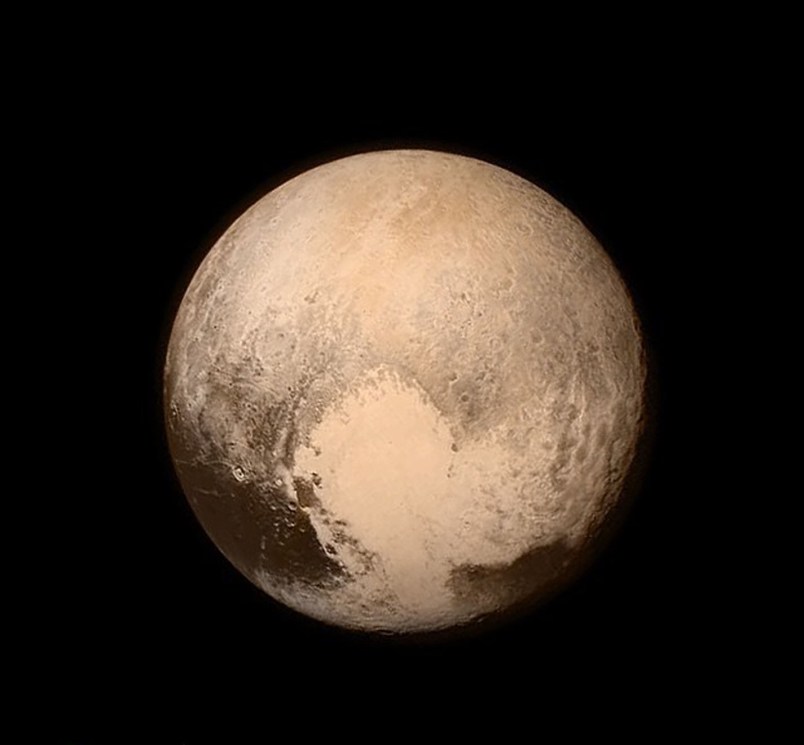CAPE CANAVERAL, Fla. (AP) — We’ve made it to Pluto by NASA’s calculations, the last stop on a planetary tour of the solar system a half-century in the making.
The moment of closest approach for the New Horizons spacecraft came at 7:49 a.m. EDT Tuesday, culminating a journey from planet Earth that spanned an incredible 3 billion miles and 9½ years.
Based on everything NASA knows, New Horizons was straight on course for the historic encounter, sweeping within 7,800 miles of Pluto at 31,000 mph. But official confirmation won’t come until Tuesday night, 13 nerve-racking hours later. That’s because NASA wants New Horizons taking pictures of Pluto, its jumbo moon Charon and its four little moons during this critical time, not gabbing to Earth.
NASA marked the moment live on TV, broadcasting from flight operations in Maryland.
“This is truly a hallmark in human history,” said John Grunsfeld, NASA’s science mission chief.
“It’s a moment of celebration,” added principal scientist Alan Stern from Johns Hopkins University’s Applied Physics Laboratory, the spacecraft’s developer and manager. “We’ve just done the anchor leg, we have completed the initial reconnaissance of the solar system, an endeavor started under President Kennedy more than 50 years ago.”
The United States is now the only nation to visit every single planet in the solar system. Pluto was No. 9 in the lineup when New Horizons departed Cape Canaveral, Florida, on Jan. 19, 2006, but was demoted seven months later to dwarf status. Scientists in charge of the $720 million mission, as well as NASA brass, hope the new observations will restore Pluto’s honor.
“It’s a huge morning, a huge day not just for NASA but for the United States,” NASA Administrator Charles Bolden said from NASA headquarters in Washington.
Inside “countdown central” at Johns Hopkins in Laurel, Maryland, hundreds jammed together to share in the remaining final minutes, including the two children of the American astronomer who discovered Pluto in 1930, Clyde Tombaugh. The actual flight control room was empty save for a worker sweeping up; the spacecraft was preprogrammed for the flyby and there was nothing anyone could do at this point but join in the celebration.
Stern led the festivity, joined on stage by his team and Tombaugh’s two children.
The crowd waved U.S. flags and counted down from nine seconds, screaming, cheering and applauding. Chants of “USA!” broke out.

Members of the New Horizons science team react to seeing the spacecraft’s last and sharpest image of Pluto before closest approach later in the day, Tuesday, July 14, 2015, at the Johns Hopkins University Applied Physics Laboratory (APL) in Laurel, Maryland. (Bill Ingalls/NASA via AP)
It takes 4½ hours for signals to travel one-way between New Horizons and flight controllers, the speed of light. The last time controllers heard from the spacecraft was Monday night, according to plan, and everything looked good.
New Horizons already has beamed back the best-ever images of Pluto and big moon Charon. Pluto also has four little moons, all of which were expected to come under New Horizons’ scrutiny. The pictures are “mind-boggling to put it mildly,” Bolden said.
As Stern told reporters Monday, “The Pluto system is enchanting in its strangeness, its alien beauty.”
The newest pictures, from the actual flyby, won’t be transmitted until well afterward so the seven science instruments can take full advantage of the encounter. In fact, it will take more than a year to get back all the data.
On the eve of the flyby, NASA announced that Pluto is actually bigger than anyone imagined, thanks to measurements made by the spacecraft, a baby grand piano-size affair. It’s about 50 miles bigger than estimated, for a grand total of 1,473 miles in diameter.
Pluto is now confirmed to be the largest object in the so-called Kuiper Belt, considered the third zone of the solar system after the inner rocky planets and outer gaseous ones. This unknown territory is a shooting gallery of comets and other small bodies.
If a mission extension is granted, New Horizons will seek out another Kuiper Belt object before heading out of the solar system — for good.

NASA has described this image as a “sneak peak of gorgeous Pluto!” They say the dwarf planet has sent a “love note” back to Earth via the New Horizons spacecraft, which has traveled more than 9 years and 3+ billion miles. This is the last and most detailed image of Pluto sent to Earth before the moment of closest approach – 7:49 a.m. EDT today (14 July). This stunning image of the dwarf planet was captured from New Horizons at about 4 p.m. EDT on July 13, about 16 hours before the moment of closest approach. The spacecraft was 476,000 miles (766,000 kilometers) from the surface. (Rex Features via AP Images)
___
Online:
NASA: https://www.nasa.gov/mission_pages/newhorizons/main/
Johns Hopkins University: http://pluto.jhuapl.edu/







Science, Technology, Engineering and Mathematics: “We built that!”
Americans who fund science and exploration: “We built that!”
Exploring humans: “We built that!”
Cost of New Horizons mission (lifetime) to Pluto and another KBO: $650 million.
We built that!
Estimated cost of the boondoggle SLS rocket: $41 billion for four launches to nowhere.
Please, don’t let us build that!
This is a stunning testament to the intelligence and creativity of the people at NASA. This was launched in 2006 and travelled over 3 billion miles to get within 7500 miles of Pluto. It’s not like driving an aerial drone with a joystick - they plot out the path in advance, and then rely on math and physics to get it there. Absolutely incredible. It’s staggering that it take like almost 9 hours for light to get to New Horizons and back. Well done, NASA!
Cost of Iraq/Afganistan war $4 to $6 trillion. That’s about $18k per man-woman-child in America. Cost for the SLS system $124 per person. Lets build the SLS System instead of fighting wars.
I love this story. A bit of Clyde Tombaugh’s ashes are on board.